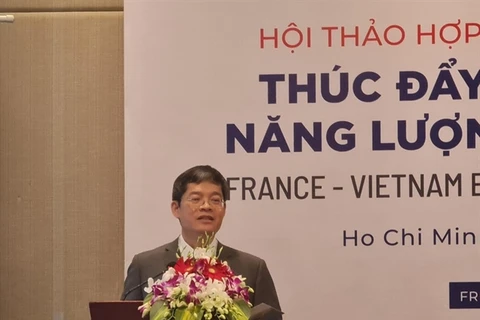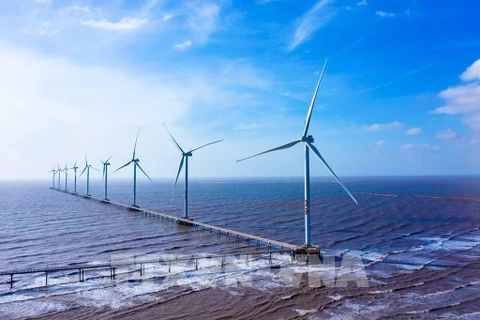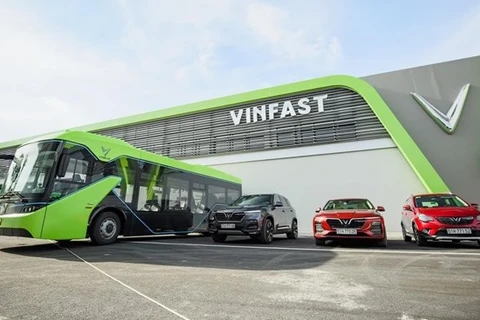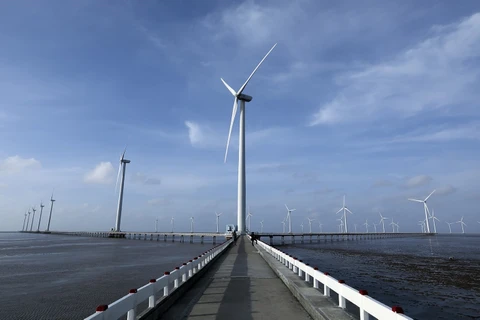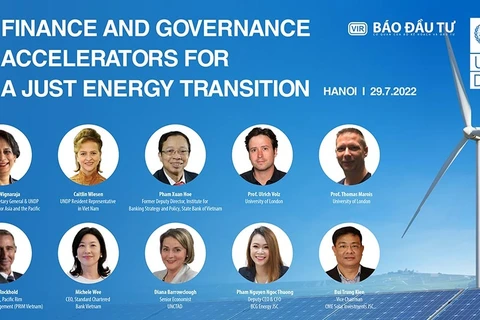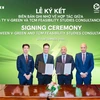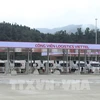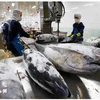Hanoi (VNA) – Despite various difficulties, the Vietnam National Oil and Gas Group (PetroVietnam) has rolled out measures to keep operations buoyant in the current situation and to engage in energy transition based on the future of the industry.
According to the firm, the electrification sector has been greatly impacted by the growth of renewable energy sources. Meanwhile, liquefied natural gas (LNG) power projects under construction must develop a plan for conversion to hydrogen fuel.
Gasoline demand in Vietnam is forecast to continue to increase and peak in 2030-2035, while the diesel oil (DO) market is likely to be affected more slowly, and the DO supply shortage is forecast to continue until 2035.
According to Binh Son Refining and Petrochemical Joint Stock Company (BSR), in the short term, energy transition has not had a clear impact on the demand for petroleum products in Vietnam. However, in the long term, it is happening globally, leading to a decrease in the demand for petroleum products.
This is a challenge for refineries to enhance the quality of their products and reduce the ratio of traditional fuels in their products and promote the development of environmentally-friendly products.
Regarding oil and gas exploration and production, oil production peaked in 2005 and is on the verge of a sharp decline. Meanwhile, even with the scenario of net zero emissions by 2050, oil is still used for non-energy purposes and in sectors that are difficult to replace fuel such as the aviation industry and sea transport. In particular, gas production is forecast to increase rapidly, but low-cost gas sources are harder to find, while new gas sources are expensive and have to compete with LNG.
As of the end of June, about 40 countries had released strategies and roadmaps on hydrogen, including leading countries in greenhouse gas emissions such as China, the US, India, Russia, and Japan. Currently, 98% of the world's hydrogen is produced from gas and coal used in oil and chemical refining.
Recently, PetroVietnam signed a memorandum of understanding with the Asian Development Bank (ADB) on cooperation in energy transition.
Meanwhile, the firm has implemented 12 major tasks related to renewable energy, greenhouse gas emission reduction, economical and efficient use of energy, hydrogen, ammonia, battery/charging systems, energy storage, coal-fueled power plant greening, and Carbon Capture, Usage and Storage (CCUS).
PetroVietnam General Director Le Manh Hung said that the firm has begun implementing the roadmap related to energy transition from 2019, but the process must be based on the national target.
Therefore, with the tasks in exploration and production, PetroVietnam will focus on implementing solutions to accelerate the exploration and exploitation of oil and gas, while considering the use of renewable energy in oil and gas exploitation activities, he said.
PetroVietnam pumped 5.48 million tonnes of crude oil in the first six months of this year, surpassing the set target by 23%.
Meanwhile, gasoline production exceeded 14% of the plan, fertiliser production exceeded 8% of the plan, production and supply of gas, electricity and other energy products is also up.
The group’s revenue in the period was estimated at 468.3 trillion VND (20 billion USD), up 55% year-on-year and double the goal set for six months.
It contributed 66.1 trillion VND to the State budget, 2.2 times higher than the half-year plan and an increase of 41% compared to the same period last year.
This is considered a remarkable achievement in a context of global geopolitical and economic instability, caused by the conflict in Ukraine, increased inflationary pressures and China's Zero COVID policy.
In 2021, PetroVietnam was listed among the three biggest companies in Vietnam behind Samsung Vietnam and Vietnam Electricity (EVN), according to the VNR500 rankings unveiled by Vietnam Report JSC.
The rankings were compiled based mainly on enterprise revenue and other performance criteria such as total assets, employees, growth rates, profits, and prestige in the media.
PetroVietnam posted revenue of 620.2 trillion VND last year, surpassing the yearly plan by 26.4%, and up 28% year-on-year./.
According to the firm, the electrification sector has been greatly impacted by the growth of renewable energy sources. Meanwhile, liquefied natural gas (LNG) power projects under construction must develop a plan for conversion to hydrogen fuel.
Gasoline demand in Vietnam is forecast to continue to increase and peak in 2030-2035, while the diesel oil (DO) market is likely to be affected more slowly, and the DO supply shortage is forecast to continue until 2035.
According to Binh Son Refining and Petrochemical Joint Stock Company (BSR), in the short term, energy transition has not had a clear impact on the demand for petroleum products in Vietnam. However, in the long term, it is happening globally, leading to a decrease in the demand for petroleum products.
This is a challenge for refineries to enhance the quality of their products and reduce the ratio of traditional fuels in their products and promote the development of environmentally-friendly products.
Regarding oil and gas exploration and production, oil production peaked in 2005 and is on the verge of a sharp decline. Meanwhile, even with the scenario of net zero emissions by 2050, oil is still used for non-energy purposes and in sectors that are difficult to replace fuel such as the aviation industry and sea transport. In particular, gas production is forecast to increase rapidly, but low-cost gas sources are harder to find, while new gas sources are expensive and have to compete with LNG.
As of the end of June, about 40 countries had released strategies and roadmaps on hydrogen, including leading countries in greenhouse gas emissions such as China, the US, India, Russia, and Japan. Currently, 98% of the world's hydrogen is produced from gas and coal used in oil and chemical refining.
Recently, PetroVietnam signed a memorandum of understanding with the Asian Development Bank (ADB) on cooperation in energy transition.
Meanwhile, the firm has implemented 12 major tasks related to renewable energy, greenhouse gas emission reduction, economical and efficient use of energy, hydrogen, ammonia, battery/charging systems, energy storage, coal-fueled power plant greening, and Carbon Capture, Usage and Storage (CCUS).
PetroVietnam General Director Le Manh Hung said that the firm has begun implementing the roadmap related to energy transition from 2019, but the process must be based on the national target.
Therefore, with the tasks in exploration and production, PetroVietnam will focus on implementing solutions to accelerate the exploration and exploitation of oil and gas, while considering the use of renewable energy in oil and gas exploitation activities, he said.
PetroVietnam pumped 5.48 million tonnes of crude oil in the first six months of this year, surpassing the set target by 23%.
Meanwhile, gasoline production exceeded 14% of the plan, fertiliser production exceeded 8% of the plan, production and supply of gas, electricity and other energy products is also up.
The group’s revenue in the period was estimated at 468.3 trillion VND (20 billion USD), up 55% year-on-year and double the goal set for six months.
It contributed 66.1 trillion VND to the State budget, 2.2 times higher than the half-year plan and an increase of 41% compared to the same period last year.
This is considered a remarkable achievement in a context of global geopolitical and economic instability, caused by the conflict in Ukraine, increased inflationary pressures and China's Zero COVID policy.
In 2021, PetroVietnam was listed among the three biggest companies in Vietnam behind Samsung Vietnam and Vietnam Electricity (EVN), according to the VNR500 rankings unveiled by Vietnam Report JSC.
The rankings were compiled based mainly on enterprise revenue and other performance criteria such as total assets, employees, growth rates, profits, and prestige in the media.
PetroVietnam posted revenue of 620.2 trillion VND last year, surpassing the yearly plan by 26.4%, and up 28% year-on-year./.
VNA

